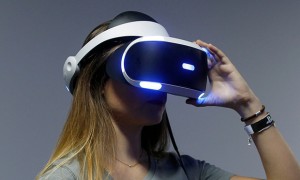Virtual Reality Headsets and Liability: What Happens In-Game Doesn’t Stay in the Game
One of the most exciting movements in the gaming and tech industries is virtual reality or VR headsets. What was considered science fiction only a few years ago is now a reality brought to everyone through headsets like the Oculus Rift, PlayStation VR and the Samsung Gear. These headsets cover your eyes completely to immerse you in the world of your video game or film experience.
A side effect of this new technology are the potential accidents that may occur while enjoying the experience. Currently, there are dozens of YouTube videos showing teenagers pushing or tripping their fully immersed VR friends. Furthermore, Six Flags is planning on developing a VR rollercoaster experience, where customers will ride a regular rollercoaster while wearing VR headsets provided by Samsung. In addition to the usual risks of riding an amusement park ride, customers will now experience the ride alongside aliens and other adventures in virtual reality.
Even without the involvement of third parties, it’s easy to become so heavily immersed in a VR experience that you briefly forget where you are in reality. An accident resulting in injury is bound to happen. 
So, what if you break your leg because of your virtual reality experience? Who would be liable?
When Nintendo first introduced the Wiimote for its Wii console, users were getting so involved with the games that they unintentionally flung their Wiimotes into their televisions, causing injury and property damage. Several class action lawsuits were filed against Nintendo, blaming the weak straps on the first generation of Wiimotes.
Nintendo eventually corrected the issue by providing thicker straps free of charge, creating a squishy rubber casing for the Wiimote, and by providing several warning labels regarding proper use of the Wiimote.
Unlike a VR headset, a Wiimote doesn’t completely obscure your senses and fully immerse you into a game. And yet, Nintendo ran into legal troubles regardless. So for VR headset manufacturers, there could be serious potential for product liability and for lawsuits regarding insufficient warnings.
Product Liability
VR headsets are just like any other product. If a product‘s design or its manufacturing have some kind of defect that causes you an injury, you may be able to sue everyone from the company that sold you a device to the manufacturing and design companies themselves.
There are three ways a product can be defective. It can be defective in design, where the actual design of the product can cause injury. A product can also be defected in manufacturing, where the design is fine but there was an issue during manufacturing that resulted in a product that causes injury.
Finally, a product can be defective if there aren’t sufficient warnings about potential hazards from using a product. So, in the case of Nintendo, they had sufficient warnings because there were several large print warnings and warning labels included in the packaging of the Wiimote.
VR headsets may need more than the standard warning labels to be sufficiently covered. In general, warning labels need to be detailed, specific, prominent and understandable. They need to make assumptions based on the foreseeable use of the product.
There are already many potential problems that can arise from the regular use of VR headsets. Motion sickness and eyestrain are some potential issues, as well as any physical injury if a person is standing with the headset instead of sitting. Some VR headsets that are used to magnify the screens on smartphones for the VR experience cannot be used outside without risk of overheating the phone or damaging the eyes from magnifying sunlight.
Finally, with the more recent issues of gaming addiction and deaths from exhaustion, VR headsets may also need to provide intermittent warnings during use. Many massively multiplayer online role-playing video games (MMORPGs) have reminders to take breaks every 30 minutes to an hour. VR headsets and/or game programmers may also need to insert similar warnings periodically to alleviate the risks of overuse.
Assuming the Risk
One of the defenses that manufacturers and designers can claim against liability is assumption of the risk. A customer assumes the risk if they know the potential risks of injury and use the product anyway.
With VR headsets, many users are already aware that they can get motion sickness, or if they stand up and move around while wearing the headset they can trip and fall. If users continue to use their VR headset while aware of these risks, then they cannot later sue manufacturers if they do happen to fall and break their leg.
For the time being, as early adopters continue to experiment with VR headsets, they may set the expectations for potential issues before these products become mainstream. One can only hope that with the adoption of these technologies that we aren’t falling head first into something that consumers are not prepared for.
What our clients think
At LegalMatch, we value our client’s opinion and make it a point to address their concerns. You can refer to our reviews page if you want to know what our clients have to say about us.

Comments
This is my first time go to see at here and i am genuinely pleassant to read
all at alone place.